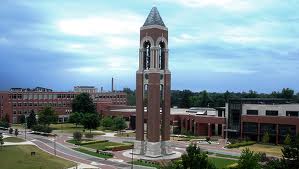As part of the Obama Administration's all-of-the-above approach to American energy, the Energy Department recently congratulated Ball State University for its campus-wide ground-source geothermal system, the nation's largest geothermal heating and cooling system.
Building on significant investment from the State of Indiana and the University, the Energy Department provided key support for the project with a $5 million grant through the American Recovery and Reinvestment Act. The Ball State system—which the university anticipates will save $2 million annually in operating costs and cut its carbon footprint by nearly 50%—is one Energy Department investment helping to reduce energy costs, diversify the nation's energy portfolio, and create clean energy jobs across the country.
Launched in 2009, Ball State's geothermal system will replace four aging coal-fired boilers to provide renewable power that will heat and cool 47 university buildings, representing 5.5-million-sf on the 660-acre campus.
To provide heating, the geothermal heat pump removes the heat from the fluid in the Earth and transfers it to the building. For cooling, the pump removes heat from the building and transfers it back into the Earth. Nearly every component of the Recovery Act-supported system was manufactured in America, and Ball State has contracted with more than 50 Indiana firms to complete the project, which included drilling 3,600 boreholes around campus.
Buildings consume about 40% of total energy in the U.S. The Energy Department's support for projects like the Ball State geothermal system underscores the Administration's commitment to clean, efficient energy solutions that can create significant costs savings. The innovative geothermal system highlighted today demonstrates the tremendous potential of sustainable energy technologies, and serves as a model for other major facilities and universities across the nation. BD+C
Related Stories
Multifamily Housing | Apr 12, 2024
Habitat starts leasing Cassidy on Canal, a new luxury rental high-rise in Chicago
New 33-story Class A rental tower, designed by SCB, will offer 343 rental units.
Student Housing | Apr 12, 2024
Construction begins on Auburn University’s new first-year residence hall
The new first-year residence hall along Auburn University's Haley Concourse.
K-12 Schools | Apr 11, 2024
Eric Dinges named CEO of PBK
Eric Dinges named CEO of PBK Architects, Houston.
Construction Costs | Apr 11, 2024
Construction materials prices increase 0.4% in March 2024
Construction input prices increased 0.4% in March compared to the previous month, according to an Associated Builders and Contractors analysis of the U.S. Bureau of Labor Statistics’ Producer Price Index data released today. Nonresidential construction input prices also increased 0.4% for the month.
Healthcare Facilities | Apr 11, 2024
The just cause in behavioral health design: Make it right
NAC Architecture shares strategies for approaching behavioral health design collaboratively and thoughtfully, rather than simply applying a set of blanket rules.
K-12 Schools | Apr 10, 2024
A San Antonio school will provide early childhood education to a traditionally under-resourced region
In San Antonio, Pre-K 4 SA, which provides preschool for 3- and 4-year-olds, and HOLT Group, which owns industrial and other companies, recently broke ground on an early childhood education: the South Education Center.
University Buildings | Apr 10, 2024
Columbia University to begin construction on New York City’s first all-electric academic research building
Columbia University will soon begin construction on New York City’s first all-electric academic research building. Designed by Kohn Pedersen Fox (KPF), the 80,700-sf building for the university’s Vagelos College of Physicians and Surgeons will provide eight floors of biomedical research and lab facilities as well as symposium and community engagement spaces.
K-12 Schools | Apr 10, 2024
Surprise, surprise: Students excel in modernized K-12 school buildings
Too many of the nation’s school districts are having to make it work with less-than-ideal educational facilities. But at what cost to student performance and staff satisfaction?
Industrial Facilities | Apr 9, 2024
Confessions of a cold storage architect
Designing energy-efficient cold storage facilities that keep food safe and look beautiful takes special knowledge.
Cultural Facilities | Apr 8, 2024
Multipurpose sports facility will be first completed building at Obama Presidential Center
When it opens in late 2025, the Home Court will be the first completed space on the Obama Presidential Center campus in Chicago. Located on the southwest corner of the 19.3-acre Obama Presidential Center in Jackson Park, the Home Court will be the largest gathering space on the campus. Renderings recently have been released of the 45,000-sf multipurpose sports facility and events space designed by Moody Nolan.

















